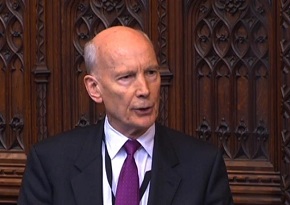Lords industrial strategy debate
In a recent House of Lords debate about the government's industrial strategy ICE President Lord Robert Mair welcomed the government's white paper as a much needed document that emphasises collaboration between government, business, science and technology.
He updated the House on the recent launch of three government infrastructure reports, which took place at ICE's headquarters, One Great George Street. The reports, he said, all recognised the urgent need to improve performance of our infrastructure to help boost the productivity of the industry and deliver better outcomes for society.
He went on to praise the Construction Leadership Council's pursuit of ensuring that the Construction Sector Deal was in the first round of deals announced in the white paper - one that could potentially transform the construction industry.
He also discussed the importance of looking at the theme of digital technology in infrastructure, particularly building information modelling (BIM), saying that it will deliver better, more certain results.
Including innovative offsite manufacturing techniques in the Construction Sector Deal is also vital he said, as it can improve productivity, quality and safety. It also has the potential to rebalance jobs more equitably throughout the country, improve value for money from public investment and minimise disruption to local communities during the construction process.
He cited the comparison between Tottenham Court Road and Liverpool Street Stations, both part of the Crossrail project. The former utilised traditional in-situ concrete technology whereas the latter utilised offsite manufacture and resulted in in hugely increased productivity.
He also called on government to focus on infrastructure's whole-life performance to get more out of both new and existing infrastructure through the use of smart technologies, especially sensors and data analytics.
Lord Mair hailed the potential that this technology has to revolutionise asset management, whereby sensors embedded within infrastructure are able to continuously monitor and feed back performance data leading to more rational maintenance and repair strategies.
He also welcomed the close to half a billion pounds that will support the Construction Sector Deal, part of which will support the new Centre for Digital Built Britain, based at Cambridge University.
The Centre will develop and commercialise the digital technologies behind smart systems at the heart of tomorrow's homes. This should, he said, lead to housing, schools and hospitals that are not only faster and cheaper to build but also cost less to run and are more energy-efficient.
He urged that the industrial strategy white paper does not stand still over time. He said it should catalyse continuous collaboration between all relevant government departments, industry and trade bodies. This includes working with the National Infrastructure Commission to ensure its National Infrastructure Assessment is incorporated in the future development of the White Paper, together with ICE's National Needs Assessment.
This article was originally published here by ICE on 7 Jan 2018. It was written by Simon Barney.
--The Institution of Civil Engineers
[edit] Related articles on Designing Buildings Wiki
- Articles by ICE on Designing Buildings Wiki.
- Building our Industrial Strategy: green paper.
- Construction Leadership Council.
- Construction sector deal.
- Construction Sector Deal launch.
- Industrial strategy.
- Industrial Strategy: building a Britain fit for the future.
- Professor Lord Mair to become ICE President.
- UK Digital Strategy.
Featured articles and news
One of the most impressive Victorian architects. Book review.
Common Assessment Standard now with building safety
New CAS update now includes mandatory building safety questions.
RTPI leader to become new CIOB Chief Executive Officer
Dr Victoria Hills MRTPI, FICE to take over after Caroline Gumble’s departure.
Social and affordable housing, a long term plan for delivery
The “Delivering a Decade of Renewal for Social and Affordable Housing” strategy sets out future path.
A change to adoptive architecture
Effects of global weather warming on architectural detailing, material choice and human interaction.
The proposed publicly owned and backed subsidiary of Homes England, to facilitate new homes.
How big is the problem and what can we do to mitigate the effects?
Overheating guidance and tools for building designers
A number of cool guides to help with the heat.
The UK's Modern Industrial Strategy: A 10 year plan
Previous consultation criticism, current key elements and general support with some persisting reservations.
Building Safety Regulator reforms
New roles, new staff and a new fast track service pave the way for a single construction regulator.
Architectural Technologist CPDs and Communications
CIAT CPD… and how you can do it!
Cooling centres and cool spaces
Managing extreme heat in cities by directing the public to places for heat stress relief and water sources.
Winter gardens: A brief history and warm variations
Extending the season with glass in different forms and terms.
Restoring Great Yarmouth's Winter Gardens
Transforming one of the least sustainable constructions imaginable.
Construction Skills Mission Board launch sector drive
Newly formed government and industry collaboration set strategy for recruiting an additional 100,000 construction workers a year.
New Architects Code comes into effect in September 2025
ARB Architects Code of Conduct and Practice available with ongoing consultation regarding guidance.
Welsh Skills Body (Medr) launches ambitious plan
The new skills body brings together funding and regulation of tertiary education and research for the devolved nation.
Paul Gandy FCIOB announced as next CIOB President
Former Tilbury Douglas CEO takes helm.

























